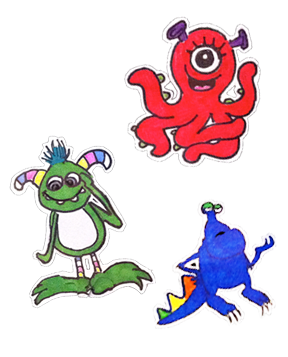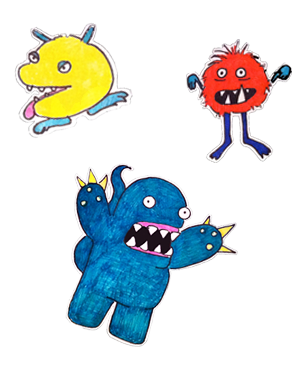BIG QUESTION: What makes monsters scary?
LESSON TITLE: My Pet Monster
GRADE LEVEL: K-2
SUGGESTED TIME ALLOWANCE: Two 45-minute class periods.
CENTRAL FOCUS/OVERVIEW:
Students will use Maurice Sendak’s “Where the Wild Things Are” as a pathway to reflect on what’s “scary” to them. They will consider what makes monsters frightening in the traditional sense (their big teeth? their sharp horns/toenails? Claws/tails? etc) and discuss how Sendak’s creatures are actually quite likeable. Together, we’ll explore how first impressions can be deceiving (how did the monsters seem at first? Large/intimidating? How about once they started smiling/dancing/being kind to Max? Etc). Students will then draw their own “friendly” — but scary looking! – monsters, and present them to the class, explaining one thing that makes them truly exceptional/worth getting to know.
In the follow-up lesson, they will have an opportunity to further explore their monsters by exploring shapes/experimenting with collage materials.
LEARNING OBJECTIVES:
• Students will reflect on what they’re afraid of and why – and see they share many of the same fears/preconceptions.
• Students will learn tolerance by starting to look at others (especially those who might be new or different from them) with an open mind.
• Students will imagine what their monsters might look/sound like, and explore how to visually express their ideas through collage art/illustration.
• Students will explore which visual elements look scary (e.g. sharp vs. round horns, claws vs. hands), and experiment with using colors, lines and shapes to make their monsters appear more frightening to the viewer.
• Students will use the concept of exterior/interior to think more about which traits their ideal monster (or real-life) friend might have.
• Students will practice using, forming and layering shapes, and experiment with creating form through felt and 3D collage materials.
RESOURCES & MATERIALS:
Lesson 1: Drawing paper, markers, sharpies. Visual aids: prepared Monster demo
Lesson 2: Colored construction paper, felt, glue, popsicle sticks, cardboard, aluminum foil, pipe cleaners, pompoms. (Optional motivation: a short clip from Monsters Inc).
PROCEDURE:
Lesson 1:
The class will open up with an introduction of “Where The Wild Things Are,” and evolve into a short discussion about what makes monsters “scary” (or not scary, as the case may be). After creating a short, student generated list of monster attributes, the class will be shown the demo projects, handed pre-cut materials and asked to design their own deceptively non-frightening monster friends. I will give a short drawing demo to show them some strategies/techniques as well as specific visual attributes they may want to emphasize (i.e. to make their creatures appear “scarier” to the untrained eye).
 As a final thought, I will encourage everyone to take thinking about their monsters after they leave (e.g. write stories, create more characters, imagine where these creatures might live, how others might react to them, etc), and remind them that we’ll be using the sketches we created today as the basis for a new project the following week.They will then spend the majority of their class time working on their individual projects while I circulate the room and ask them about their work/ideas. Towards the end of the period, I will pass around a quick (optional) worksheet and give them a few minutes to elaborate on what makes their monster special/unique. After a short cleanup, we will put the artworks up on the wall/table, and have a class discussion (where each child will hold up his work and explain what makes his Pet Monster special).
As a final thought, I will encourage everyone to take thinking about their monsters after they leave (e.g. write stories, create more characters, imagine where these creatures might live, how others might react to them, etc), and remind them that we’ll be using the sketches we created today as the basis for a new project the following week.They will then spend the majority of their class time working on their individual projects while I circulate the room and ask them about their work/ideas. Towards the end of the period, I will pass around a quick (optional) worksheet and give them a few minutes to elaborate on what makes their monster special/unique. After a short cleanup, we will put the artworks up on the wall/table, and have a class discussion (where each child will hold up his work and explain what makes his Pet Monster special).
Lesson 2:

I will begin the class by watching a short clip from Monsters Inc. and revisiting the idea of what makes monsters scary (e.g. sharp teeth/horns/claws, loud noises, tentacles, tails/scales, wings, an unusual number of eyes, arms or legs). I will also review the list of monster attributes and give a brief demonstration of the materials (how to make eyes, a head/body, add horns or scales) before inviting the students to begin constructing their own monster shape-collages. Before students start working, I will ask the students to think of one thing they’d like to share about their monsters at the end of class — name, super power, etc. After students get their monster collages underway, I will come around to ask them questions, offer suggestions and get a sense of each one’s concept/idea. Should it be necessary, I will also review the proper use of the materials or suggest that they start with a sketch (or try placing the felt/paper where they want them before gluing them down).
Although some students will finish early (and use the rest of class to draw on their own), I will facilitate an early clean-up to give us time to do a gallery walk or quick circle-critique of everyone’s art. The class will end with this discussion and an invitation
to bring in more monster drawings/ideas next week (or create a monster-themed book in free draw).
FORMAL ASSESSMENT OF STUDENT WORK: –
VISUAL ARTS STANDARDS:
• Standard 1: Creating, Performing, and Participating in the Arts. Students will actively engage in the processes that constitute creation and performance in the arts (dance, music, theatre, and visual arts) and participate in various roles in the arts.
• Standard 2: Knowing and Using Arts Materials and Resources. Students will be knowledgeable about and make use of the materials and resources available for participation in the arts in various roles.
• Standard 3: Responding to and Analyzing Works of Art. Students will respond critically to a variety of works in the arts, connecting the individual work to other works and to other aspects of human endeavor and thought.
• Standard 4: Understanding the Cultural Contributions of the Arts. Students will develop an understanding of the personal and cultural forces that shape artistic communication and how the arts in turn shape the diverse cultures of past and present society.